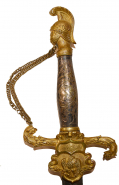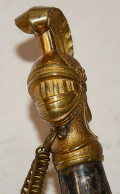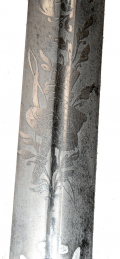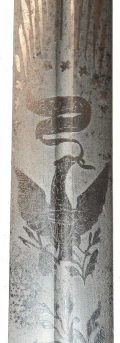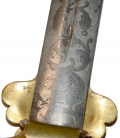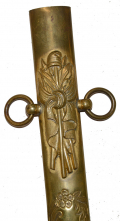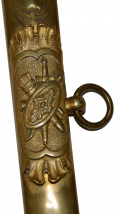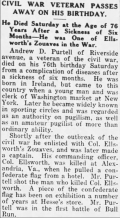site search
online catalog
AMES 1859 PRESENTATION MILITIA OFFICER’S SWORD OF CAPTAIN ANDREW DONOVAN PURTELL, LATER CAPTAIN IN ELLSWORTH’S ZOUAVES

$3,375.00 SOLD
Quantity Available: None
Item Code: 870-215
This is very nice looking sword in very good condition with a soft, but not dark patina to gilt brass hilt and scabbard and silver grip and nice, bright blade with very visible etching showing just some slight graying. The pommel is a plumed, Greco-Roman style helmet with a barre visor, from which a double chain knuckle bow connects with the upper facing end of the S-shape guard. The grip is sheet silver engraved with geometric and floral motifs. The quillons of the guard terminate in sea-monster heads with scaled bodies back to budding floral shoots coming out of the quillon block. The obverse has a wide langet, with scrolling, foliate, raised border and stippled ground showing a perched eagle with raised wings.
The blade is straight, double edged with spearpoint tip and narrow central fuller, etched on both sides. The obverse has a long tendril of acorns, followed by a small vine entwined trophy of arms consisting of shield, bow, and quiver, with the vines extending above. Over this is an American eagle with raised wings, arrows and olive branch, and E Pluribus Unum dry needle etched ribbon under a sunburst glory of stars and sun rays. The panel finishes off with a snaking leafy branch and the frosting terminates with in a leafy, flamboyant edged point. The reverse has the Ames Mfg. Co. / Chicopee / Mass address at bottom with floral scrolls with tendrils and acorn ends extending above, followed by a short floral scroll and then tall stand of arms with furled flags on crossed pikes with Liberty Cap on pole rising at the center, with a burst of sun rays overhead, the etching finishing off with an another floral scroll and leafy vine extension. The blade has a good edge and point. The etching is very good, bright and fully visible, though with some rubbing and a few small gray spots, which show on the unetched upper portions of the blade also.
The scabbard is fitted with three carrying rings, two at top and one at the midpoint. The rings have simple edge loop mounts, but with raised panels beneath: the upper with Liberty Cap on pole with banners from pikes knotted around it at center, and the lower showing a trophy of arms consisting of sword, quiver, and oval shield. The drag is cast in the form of a quiver with the feathered ends showing at top, and the body bound with crossing straps, making it look slightly like the bound rods symbolizing the republic, ending with a foliate button finial. Between the lower mount and this decoration, the scabbard is engraved with a long sequence of leafy vines starting with a geometric and foliate panel just below the middle mount. Between the two upper mounts is another engraved, or impressed panel, with floral border, engraved in the middle, “Andrew D. Purtell.” The reverse of the scabbard is plain, but bears the stamped Ames company address at top and between the upper and lower carrying rings is engraved: “Presented to / Captain Andrew D. Purtell / by his friends / as a token of respect and esteem / Sept. 28th 1859.”
The occasion of the presentation is not stated, nor is Purtell’s organization, but given the uncommon name the recipient is most likely Andrew Donovan Purtell, born in Ireland in 1840 and before the war employed as a clerk in New York City. This would make him only 19 years of age when given the sword, rather young to be a Captain, but it is possible the rank and presentation refers to command of a fire company, since at the beginning of the war he was connected with Engine Company 14 and was chosen Captain of Co. K of the Ellsworth Zouaves, the company drawn from Engine 14, in 1861, at age 21 and records might be off slightly, since he listed himself as age 23 at that point. In any case, he was likely an impressive character: at his death in 1916 he was noted to have been active in sporting circles, an authority on pugilism, and “an amateur pugilist of more than ordinary ability.” If nothing else it likely gave him some authority.
The story of Ellsworth’s Zouaves does need not repeating at length: “receiving the consent of the President, he [Ellsworth] hastened to New York to raise a regiment of firemen — a class of men that he conceived to be the best adapted from their accustomed exposure to privations, for the Zouave discipline. He arrived in New York on the 18th of April, and laid his plans before the chief of the fire department, and received his cordial consent and co-operation On the 19th called together a number of the principal men of the department; on the 20th selected his officers; on the 21st mustered one thousand men; on the 22d drilled them; on the 23d inspected them; on the 24th commenced giving them uniforms; on the 25th had them in quarters; on the 26th was waiting for supplies; on the 27th received them, and on the 29th marched through the streets of the city en-route for the steamer ''Baltic" and the seat of war, 1,200 strong.”
Purtell enrolled April 20, giving his age as 23, was mustered in as Captain of Company K on May 7, and officially commissioned as Captain on July 4, with rank from April 20. Ellsworth was killed in the occupation of Alexandria in late May, of course. One obituary credits Purtell with being the man who shot the hotelkeeper who killed him, though that honor is universally awarded to Francis Brownell. His obituary also credits him with participation in the battle of First Bull Run, where the regiment took significant casualties on Henry House Hill. A newspaper report says that he had been in New York City and was also on the sick list for a time from an injury to his arm, but was back on duty by June 19. After the battle the regiment was sent back to New York for a time to recruit and upon return south was posted around Newport News. It returned to New York again on May 7, but efforts to reorganize and again take the field failed. For some reason Purtell was cashiered to date May 7 as well. This may have had something to do with morale and problems in reorganizing the regiment so it could again take the field. Several unhappy officers end up in other units. He does not have subsequent field service, but appears again in later efforts to organize the Second Fire Zouaves in New York City, who did not succeed in becoming a distinct unit, but became part of the 73rd New York. Company K of that organization was commanded by Capt. Michael D. Purtell, also connected with Engine 14, certainly a relative, and later killed in action at Spottsylvania in 1864.
After the war Andrew Purtell entered the hotel business in NY City, where he had some involvement in politics as well before moving to Little Silver and then Red Bank, NJ, where continued in the hotel trade, retiring in 1899 and dying in 1916, predeceased by his wife, but survived by four daughters and a son of at least nine children born to the couple. His life had an interesting turn toward coincidences of date: he was commissioned and cashiered on May 7, and he was born and died on March 4. This is an interesting sword, with room for more research and a strong connection with early fire companies. [sr] [ph:L]
~~~~~~~~~~~~~~~~~~~~~~~~~~~~~~~~~~~
THIS ITEM, AS WITH ALL OTHER ITEMS AVAILABLE ON OUR WEB SITE,
MAY BE PURCHASED THROUGH OUR LAYAWAY PROGRAM.
CLICK HERE FOR OUR POLICIES AND TERMS.
THANK YOU!
Inquire About AMES 1859 PRESENTATION MILITIA OFFICER’S SWORD OF CAPTAIN ANDREW DONOVAN PURTELL, LATER CAPTAIN IN ELLSWORTH’S ZOUAVES
For inquiries, please email us at [email protected]
Most Popular
Historical Firearms Stolen From The National Civil War Museum In Harrisburg, Pa »
Theft From Gravesite Of Gen. John Reynolds »
Selection Of Unframed Prints By Don Troiani »
Fine Condition Brass Infantry Bugle Insignia »
British Imported, Confederate Used Bayonet »
Scarce New Model 1865 Sharps Still In Percussion Near Factory New »
featured item
SILVERED PRESENTATION FIFE TO MARTIN MURPHY, 4th NEW YORK VOLUNTEERS, 17th NY VETERAN ZOUAVES, AND REGULAR ARMY
This elegant silvered fife, 15-1/4” long, bears a great presentation and was carried by a company musician with Civil War service in two New York regiments, one of them a zouave regiment, and substantial service in the regular army. He seems to… (1268-167). Learn More »
site search
Upcoming Events
APRIL 12-13: SPRING GETTYSBURG MILITARY ANTIQUES SHOW; All Star Events Complex Learn More »





